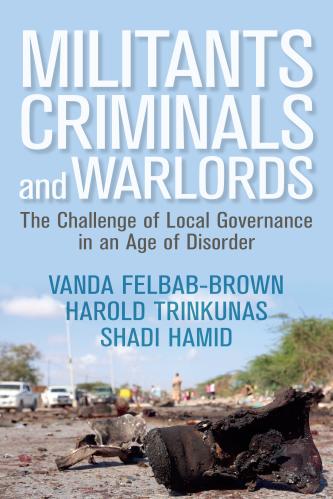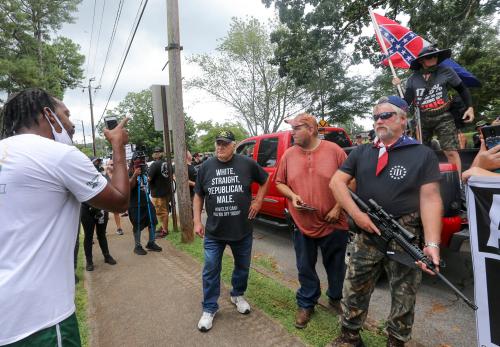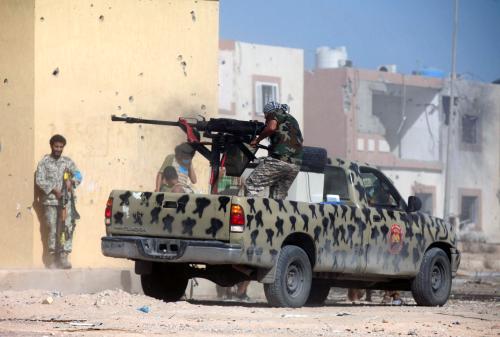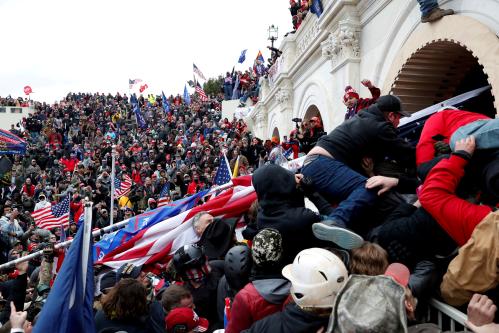This piece is part of a series titled “Nonstate armed actors and illicit economies: What the Biden administration needs to know,” from Brookings’s Initiative on Nonstate Armed Actors.
The domestic threats that have come to the fore in recent weeks have long been in the making. They precede Donald Trump’s refusal to accept his reelection loss and his egregious encouragement of his supporters — which include right-wing armed groups — to storm the U.S. Capitol on January 6. They go deeper than the possibility of insider threats, such as within the U.S. National Guard. Exacerbated by new political polarization and by Trump, right-wing armed groups have been mobilizing and gaining an increased sense of impunity since the 1990s. They are now capitalizing on the economic hardships and political unrest associated with the COVID-19 pandemic.
Right-wing armed groups won’t disappear after inauguration, even as they pose a bigger threat to U.S. democracy and rule of law than any organized crime group, and have killed more Americans in recent years than foreign terrorists. The threat of such groups and their political cooptation by Trump’s political supporters will persist long into the Biden administration. Countering this must be a high priority.
In a recent piece, Daniel Byman outlined the factors likely to shape white supremacist groups in 2021. Here, I lay out some steps to counter them and adjacent groups. I focus on right-wing groups because they currently threaten U.S. rule of law far more than left-wing armed groups, but many of these policy responses would apply to both.
The origins and power of right-wing armed groups
Right-wing armed groups in the United States include a swirl of white supremacist, anti-immigrant, anti-federal-government, pro-gun-ownership, and survivalist groups who envision a coming civil war in the United States. So-called accelerationists and Boogaloo Bois seek to advance it. These varied movements are separate from each other but sometimes intermesh, a trend accelerating during the Trump presidency. Some individuals are members of multiple groups at the same time, while rejecting others. The number and membership in right-wing armed groups increased when Barack Obama was elected president, with their recruits outraged by the election of a Black president with a strong liberal agenda.
Some white supremacist groups go back decades. Others were formed more recently: For example, the Proud Boys — who describe themselves as “western chauvinists” opposed to “white guilt,” and who espouse anti-Muslim and misogynist views — were established in 2018.
Many of anti-federal-government groups originated in the Sagebrush Rebellion of the 1970s and the associated County Supremacy movement, which resisted federal government ownership of land in the western United States and denounced the authority of the federal government, considering elected county sheriffs the highest legitimate authority.
Self-styled anti-immigration militias have operated on the U.S.-Mexico border since the early 1990s. Survivalist groups were given particular boost in 2011 with the formulation of the so-called American Redoubt ideology that predicted a U.S. civil war and encouraged migration to Wyoming, Idaho, and Montana.
Indeed, ideological formulation has been one of the sources of these groups’ growth. With its demagogical conspiracy theories against leading members of the Democratic Party, QAnon has infused the armed-group ecosystem with mass mobilization, for example — offering followers social membership and a cult-like quasi-religion.
In addition to formulated ideologies, other sources of strength of right-wing armed groups have included U.S. involvement in wars, economic dislocation, and political complicity and law enforcement weakness that generate a sense of impunity.
Going to back to the Vietnam War and even World War II, U.S. wars have left behind veterans who suffer from post-traumatic stress disorder and social dislocation. Some have become an important source of recruits for right-wing armed groups. Veterans of the Iraq and Afghanistan wars of the past 20 years similarly swelled the ranks of current right-wing armed groups. Such well-trained veterans are of unique value to the groups, increasing their capability and capacity for violence and helping these groups build political capital.
The economic dislocation caused by the COVID-19 pandemic and government response measures have become a third source of strength for right-wing armed groups, as it has for jihadists and other militants around the world. Armed right-wingers used it to violently challenge government “violations of personal freedoms.” The most prominent example is the storming of the Michigan state capitol by the heavily-armed Michigan Liberty Militia to compel Democratic Governor Gretchen Whitmer to call off the COVID-19 lockdown in March 2020.
By forcibly assisting the reopening of stores in defiance of local COVID-19 ordinances, armed groups have exploited COVID-19 to build political capital with disgruntled and impoverished businesses and politicians. Opportunities to build such capital will increase — along with violent local clashes — if the Biden administration implements a new COVID-19 lockdown to lower the devastating virus toll before vaccines can generate adequate community immunity. Right-wing armed groups have also offered their “anti-crime” and protection services to county governments, as well as armed “election-monitoring,” illegal as such acts are, to right-wing politicians.
The complicity of Trump and other politicians has been the fourth source of strength of right-wing armed groups. Even after their egregious crimes, such as the kidnapping plots against Whitmer and also Virginia Governor Ralph Northam, Trump and some other Republican leaders oscillated between meek responses, silence, and encouragement of these groups. Their efforts to appropriate the groups for political purposes imbued the latter with a sense of impunity. Research from around the world shows that the threat militant groups pose grows when politicians tolerate and use them.
Weak law enforcement and law enforcement acquiescence to the groups’ activities also increase their sense of impunity. For example, while motivated by appropriate efforts to avoid bloodshed, the government’s leniency toward the anti-federal-government Bundy group — which took over national wildlife refuges and called in armed groups from around the United States to prevent federal law enforcement officers from carrying out their duties — emboldened the groups. Any acquiescence by local sheriffs or federal border forces in the face of their efforts to apprehend undocumented workers — which is illegal — pushes their sense of impunity even higher. Arresting militia members who engage in crimes is crucial. Even so, groups such as the Oath Keepers seek recruits among former and current law enforcement officials.
Policy responses must include multifaceted law-enforcement actions; steps to counter growing political capital, recruitment, and broader political polarization; and reintegration efforts.
Law enforcement responses
First, U.S. law enforcement must look for opportunities to arrest and indict members of these groups for violating the law. The efforts that followed the U.S. Capitol riot — identifying and prosecuting rioters, as well as those who planted explosives and planned taking hostages — should have followed the storming of the Michigan capitol, too. From this point forward, any illegal acts by members of these groups must be met by overt law enforcement responses and effective prosecution.
Even though mitigating bloodshed remains a top priority, U.S. democracy can no longer tolerate armed groups getting away with threats such as the 2016 Malheur National Wildlife Refuge takeover. Mounting frequent, effective prosecutions is critical for boosting the crucial deterrence capacity of U.S. law enforcement. Moreover, those who are convicted of felonies are no longer able to lawfully possess firearms.
Like the exemplary FBI undercover operation that averted the kidnapping of Governor Whitmer, sting operations to disrupt dangerous plots and identify members and modalities of violent networks remain some of the most powerful and effective tools, and will need to be a staple of the U.S. law enforcement response.
Nonetheless, while it makes sense to talk about the behavior of right-wing armed groups as domestic terrorism, legally designating them as such would be counterproductive. Legal obstacles, such as the landmark 1972 case United States v. U.S. District Court, could make it difficult to apply a terrorism designation to U.S. domestic groups. Importantly, they are associated with extraordinary exercises of executive power and sometimes the limitation of normal criminal due-process procedures that are at the core of U.S. democracy and rule of law. Moreover, there is no easy off-ramp from terrorism designations. The associated prohibition on providing material support to terrorists critically hampers U.S. efforts overseas to build defector programs and provide rehabilitation and reintegration assistance to former militants, as well as to the broader population. The side effects of a terrorist designation thus undermine U.S. stabilization policies abroad and should be avoided in our domestic policy. Such designations could even preclude correctives as basic as in-prison and post-prison rehabilitation.
Although law enforcement efforts are key, flooding U.S. prisons with right-wing offenders could generate problems. White supremacist groups, such as the Aryan Brotherhood, long thrived in U.S. prisons; recall that dangerous criminal groups such as the Mara Salvatrucha (MS-13), Calle 18, and the Mexican Mafia were born in or fostered by prisons in the United States and abroad. Imprisoning jihadists and mixing them in with general prison populations has intensified jihadi recruitment, from Western Europe to Indonesia. Diligent monitoring of the prison activities of U.S. armed group offenders is critical, as is countering their recruitment efforts and providing support for their rehabilitation and reintegration after release.
Other policy responses
Second, prevention is also necessary outside of prisons. Like law enforcement, it includes several strands. Mapping the extent of and then countering armed-group infiltration into the U.S. military and police forces is essential. The latter is likely to be difficult since there are almost 20,000 separate police agencies in the United States. Elected county sheriffs may be sympathizers of members of armed groups themselves. Careful thinking is needed to set up robust insider threat programs and Department of Justice (DOJ) oversight mechanisms, akin to the system by which the DOJ sometimes puts police departments into receivership, such as for police brutality. Offenders who are members of the military and police forces will need to be rooted out and held to account.
Third, the United States must reconsider how it prosecutes its counterterrorism interests abroad to reduce the dangerous domestic blowback. Open-ended U.S. wars feed right-wing armed groups at home, and veterans need much better psycho-social (and economic) assistance to deal with trauma and reintegrate into society.
Fourth, removing right-wing armed groups from social media is a critical component of reducing recruitment and the groups’ planning, financial, and operational capacities. At the same time, online platforms provide very useful mechanisms for law enforcement infiltration.
Fifth, countering dangerous conspiracy theories of groups such as QAnon is also important. Yet two decades of efforts to prevent and counter jihadi extremism indicate that just telling people who espouse extremist beliefs that they are wrong only sometimes works. While embraced by governments receiving Western funds, such ideological reeducation often proves disappointing, and can even be a distraction from addressing root causes. What may be more effective is teaching civics, critical thinking, and peer resistance at an early age, similar to the approach that has produced some positive results in preventing drug use and bullying. Lessons from countering violent extremism, anti-gang efforts, and broader behavioral change approaches show that persuasive influencers often come from within, such as former believers and defectors. Moreover, if people join as a small network (of friends or family), they are more likely to leave a violent group if they do so as a network. Many people with extremist views will never be persuaded about the illogic or immorality of their beliefs. The maximum achievable goal may be to prevent them from engaging in violence and crime, or spreading propaganda.
Finally, limiting the political capital of right-wing armed groups is fundamental. All U.S. politicians must start resolutely condemning violence and thuggery of any kind. We must mobilize voters not to elect politicians with sympathies or vocalized support for violent armed groups. Any politicians who are found to be legally complicit must face prosecution.
But countering these groups’ political capital also needs to focus on the broader society that supports them. In the short term, that means providing adequate economic assistance to businesses and people who have been impoverished by COVID-19 and the associated lockdowns. In the medium turn, it includes improving education, health care, job training, and social services to those whose left out from U.S. economic prosperity and upward mobility over the past three decades.









Commentary
How to counter right-wing armed groups in the United States
January 21, 2021